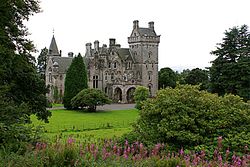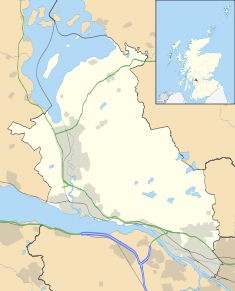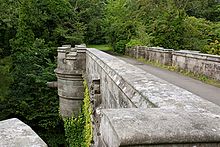- Overtoun House
-
Overtoun House Overtoun HouseLocation: Milton, West Dunbartonshire, Scotland Coordinates: 55°57′07″N 4°31′32″W / 55.9520°N 4.5256°WCoordinates: 55°57′07″N 4°31′32″W / 55.9520°N 4.5256°W Built: 1863 Built for: James White Architect: John Smith Architectural style(s): Scots Baronial Listed Building – Category A Designated: 3 March 1971 Reference #: 24907 Inventory of Gardens and Designed Landscapes in Scotland Criteria: Historical
ArchitecturalDesignated: 2007 Overtoun House is a 19th-century country house and estate in West Dunbartonshire, Scotland. It is located on a hill overlooking the River Clyde, 2 kilometres (1.2 mi) north of the village of Milton, and 3 kilometres (1.9 mi) west of the town of Dumbarton. The house was built in the 1860s, and was gifted to the people of Dumbarton in 1938. It was subsequently a maternity hospital, and now houses a Christian centre. The house is protected as a category A listed building,[1] while the grounds are included in the Inventory of Gardens and Designed Landscapes in Scotland.[2]
Overtoun Bridge, an arched approach bridge over the Overtoun Burn, has gained media attention because of the unusually large number of dogs that have reportedly leaped to their deaths there over a number of decades.[3]
Contents
Estate history
White family
In 1859, James White, a retired lawyer and a co-owner of the J&J White Chemical Works in Rutherglen, bought Overtoun Farm with the purpose of building a mansion there.[4] He intended for it to be a country retreat, and initially acquired 900 acres (360 ha); he soon increased this to 2,000 acres (810 ha). White hired the Glasgow-based architect James Smith (1808–1863) (father of the murder suspect Madeleine Smith) to design and construct the house. A farmhouse on the site was demolished to make way for the mansion.[4] Overtoun House was built between 1860 and 1863,[1] though Smith died before work was completed, and the house was completed by one of his partners. White's family began living in the mansion in 1862. It is recorded that the grounds were laid out by Mr C Kemp of Birkenhead, which is thought to refer to the landscape gardener Edward Kemp (1817–1891), who was superintendent of Birkenhead Park for Joseph Paxton.[4]
In 1884 James White died, and his son John moved to the estate in 1891 after the death of his mother. John White wanted the house to be expanded further, so he came to an agreement in 1892 with a local pastor, Reverend Dixon Swan, the heir to the adjacent Garshake Farm lands. Under the deal, John White was able to lay out the West Drive and its lodge. The eastern and western sides of the estate were split by a waterfall on the Overtoun Burn. To connect the two sides, a road was built and the Overtoun Bridge erected to designs by Henry Milner, son of Edward Milner.[4]
John White took the additional surname of Campbell, and was elevated to the peerage as Baron Overtoun in 1893. However, he died childless in 1908, and was succeeded by his nephew Dr Douglas White, a London-based GP. Lady Overtoun continued to live in the house until 1931, after which Dr White, who seldom visited Scotland, gave the house to the people of Dumbarton in 1938.[4]
Later reuse
During World War II, the British government had the house's interior utilities and furniture moved over to London.[citation needed] The house remained mainly isolated, but it was not damaged by the bombings of the nearby Clydeside shipyards.
In 1947, Overtoun was turned into a maternity hospital.[4] A fire destroyed part of the house in 1948, although there were no deaths, and the hospital remained in operation until 1 September 1970. By this time many of the garden structures, including a folly castle and the walled garden, had been demolished.[4] In 1975 the British government decided to use the house as a base for its Quality of Life Experiment.[citation needed] From 1978 to 1983, a religious group, the Spire Fellowship, utilised the home, and from 1984 to 1994, the estate was used by a group named Youth with a Mission.[citation needed]
The house fell into abandonment soon after Youth with a Mission left the area, but in 2001 Pastor Bob Hill from Fort Worth, Texas, leased the property from West Dunbartonshire Council to use as a Christian centre for Scottish youth. Renovations to the house are currently underway to repair extensive damage and to better use the facility. Specifically, the services that will eventually be provided include but are not limited to: youth sports/life training, residential care for expectant teenage mothers, short term care for mothers in crisis, family and leadership training, counselling centre, and tearoom and bed and breakfast.[citation needed]
Dog deaths at Overtoun Bridge
Studies have shown that since the 1950s or 1960s numerous dogs have leaped from the bridge at the rate of about one dog a month. Dogs that leap over the bridge parapet fall 50 feet (15 m) onto the waterfalls below. Some dogs that survived this drop, and were then taken back to the bridge, have also jumped again. The only linking factors for this unexplained event is that dogs mostly jump from same side of the bridge, in clear weather, and they are breeds with long snouts.[5]
As the unexplained phenomenon received international media attention, the Scottish SPCA sent an animal habitat expert to investigate the causes as to why dogs kill themselves at Overtoun Bridge. Initially Dr David Sands examined sight, smell and sound factors. After eliminating what a dog could potentially see and hear on the bridge, he eventually focused on scent following the discovery of mice and mink in undergrowth on the side of the bridge from which dogs often leaped. In a test, the odours from these animals were spread around an open field. Ten dogs were unleashed - representing the commonest breeds that jumped off the bridge. Of the dogs tested, only two showed no interest in any of the scents while nearly all the others made straight for the mink scent. Sands concluded that, although it was not a definitive answer, the potent odour from male mink urine was luring keen-nosed dogs to their deaths.[5]
References
- ^ a b "Overtoun House: Listed Building Report". Historic Scotland. http://hsewsf.sedsh.gov.uk/hslive/hsstart?P_HBNUM=24907. Retrieved 2011-03-22.
- ^ "Overtoun". An Inventory of Gardens and Designed Landscapes in Scotland. Historic Scotland. http://www.historic-scotland.gov.uk/index/heritage/gardens/gardenssearchsummary.htm?s=dalmeny&r=&bool=0&PageID=2448. Retrieved 2011-03-22.
- ^ Sands, David. "Overtoun Bridge Mystery". Animal Behaviour Clinic. http://www.problempets.co.uk/media/overtounbridge.asp. Retrieved 2011-03-22.
- ^ a b c d e f g "Overtoun: Site history". An Inventory of Gardens and Designed Landscapes in Scotland. Historic Scotland. http://www.historic-scotland.gov.uk/index/heritage/gardens/gardenssearchmoreinfo.htm?s=&PageID=2448&more_info=Site. Retrieved 2011-03-22.
- ^ a b "Why have so many dogs leapt to their deaths from Overtoun Bridge?". Daily Mail. 17 October 2006. http://www.dailymail.co.uk/news/article-411038/Why-dogs-leapt-deaths-Overtoun-Bridge.html.
External links
- Overtoun House: A Christian Centre For Hope And Healing
- West Dunbartonshire's Parks, including Overtoun Estate
Categories:- Listed houses in Scotland
- Listed buildings in West Dunbartonshire
- Houses completed in 1863
- Category A listed buildings in Scotland
- Scottish baronial architecture
- Inventory of Gardens and Designed Landscapes
Wikimedia Foundation. 2010.



